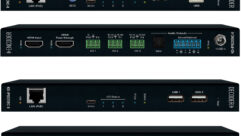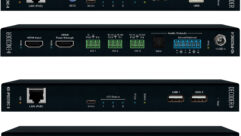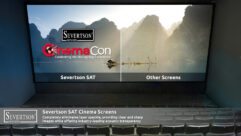Next Generation AV
Dec 20, 2013 12:14 PM,
By Bill Seamans, CTS-D
Today’s Questions, Tomorrow’s Answers
AV systems have come a long way in recent years. The projectors, podiums, and two-way videoconferences that have been installed during the past few years are being replaced by high-resolution flatpanel displays, presenters with digital tablets working the room, and virtual meetings where participants from around the world share documents and collaborate in realtime. The realms of IT teams and AV integrators have converged. Previously unimaginable innovations lay ahead, such as 4K ultra HD display technology, cloud-based video teleconferencing, and wireless video.
In today’s radically evolving industry, it’s more challenging than ever for AV contractors to know which trends to keep up with. Guess incorrectly and you’re stuck with an unhappy customer whose expensive investment will soon be obsolete. Case in point: A company that modernized its AV system in 2010 didn’t see the need to support digital video, and is now facing the challenges of scraping or upgrading a system which has not been fully depreciated yet.
Here are some questions and answers that can help you guide your clients to the best decisions:
Q: What’s driving all of this change?
A: Consumers (and their increasingly wired—and wireless—world)
From multiple screens to maximum bandwidth, today’s tech-savvy consumers equip their homes with the latest digital gadgets and network innovations. What they enjoy at home is now starting to drive what they want in their boardrooms and conference spaces. Amid the proliferation of technologies are three experience musts for meeting high expectations:
· Higher resolution: A typical household TV transmits images of two megapixels. A 4K ultra-HD TV increases this resolution to eight. Traditional AV projectors are not keeping up. For example, 1920×1080 represents the very highest native resolution reported for only one of PC Magazine’s top 10 projectors. It’s a gap that AV integrators must be ready to bridge as more content is gathered through high-resolution cameras (and watched by viewers accustomed to sharper images).
· Greater ease of use: User-friendly consumer media devices have wound up spoiling users when it comes to the more complicated tasks, such as hooking their laptop or tablet up to a traditional AV system. They also have raised expectations for functions not yet possible via traditional conference room AV systems, such as surfing the Internet via TV screen.
· Advanced portability: Moving around the room, interacting with others—today’s meeting participants refuse to restrict themselves to the space immediately in front of them, whether on a screen or around a table. Can the AV systems you propose deliver the all-around wireless access and seamless connectivity this scenario demands?
Q: In which areas are these changes causing the most challenges for AV integrators?
A: Compatibility and security
The bring-your-own-device (BYOD) movement brings a host of compatibility issues. Devices in a conference room today represent a hodgepodge of makes, models, firmware versions, and ages and a wide range of capacities for displaying HD images and video. Can a system support optimum resolution and refresh rates for all? It is important to consider the emerging technologies that your customers’ systems will need to support and design accordingly.
BYOD is also forcing AV integrators to navigate the move from video graphics array (VGA) analog video to high-definition multimedia interface (HDMI) or DisplayPort digital signals. Five years ago, you could expect all laptops to have a VGA connector. Now these devices are VGA/HDMI or just HDMI. A modernized AV system now needs to accommodate both—as well as any new technologies that come down the pipeline that gain widespread adoption.
Connectors are just the tip of the iceberg. Can an AV system accommodate the high-bandwidth digital content protection that manufacturers are building into laptop hardware as a safeguard against intellectual property theft? And what about virtual meetings? Without the right videoconferencing and collaboration capabilities, teams in an increasingly global and dispersed business world will not be able to work together effectively. Can videoconferencing infrastructure support a dozen or more participants logging in worldwide from mobile devices or multi-screen desktops? Will a video as a service strategy serve your client better than investment in private hardware infrastructure? Will the system be intuitive and easy for participants to use?
Furthermore, as AV becomes more of a wireless affair, setting boundaries for security becomes more complicated. Integrators must keep current on safeguards and technologies that prevent the spread of financial, HR, and other sensitive data beyond the meeting room, such as controlled access keys or other advanced log-in capabilities.
Q: How can an AV integrator avoid next-gen AV pitfalls?
A: With a sound strategy and broad perspective
Seeing the big picture means AV integrators must understand the IT side, including the components that comprise a network and the industry’s many standards and regulations. Keep in mind the fifth of Stephen R. Covey’s Seven Habits of Highly Effective People: “Seek first to understand, then to be understood.” As integrators, it is important for us to have a thorough grasp of the networks into which our systems will be integrating and be able to speak intelligently about how this integration needs to happen.
A dual perspective will guide AV contractors to the right questions. For instance, how will video and voice bandwidth requirements impact the IP network traffic? As an AV integrator, you may not have psychic powers. But by keeping your ear to the ground and your eye on developments across all aspects of the industry, you’ll get a better handle on the future in our rapidly changing, converging industry. By asking and finding answers to the right questions, you will add value to your client relationships and help them deliver a satisfying customer experience today and throughout the trends and technological innovations of tomorrow.
Bill Seamans, CTS-D ([email protected]) is the AV practice manager at Vision Technologies. He has 25 years of experience in the AV industry, including sales, engineering, and management roles on a wide range of projects including: conference, performance, worship, athletic, government, and commercial facilities.










